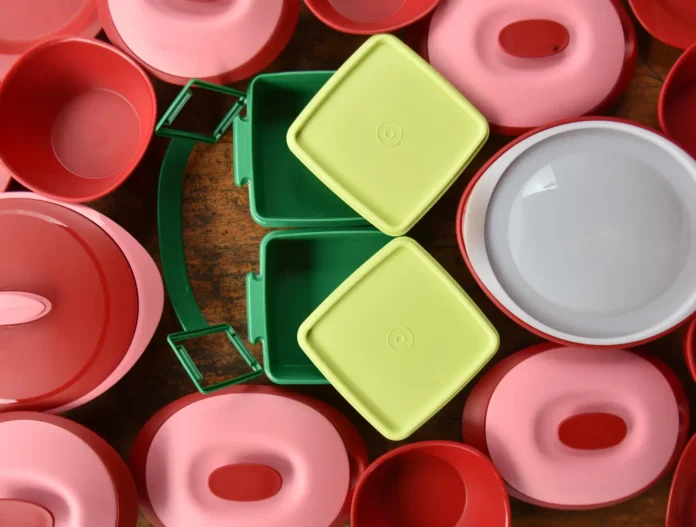Tupperware files for bankruptcy after years of declining sales, increasing competition, and financial struggles. Learn more about the brand’s challenges and future.
Originally a household name connected with creative food storage ideas, Tupperware has filed for bankruptcy. This development signals the end of a protracted fight characterized by declining sales, rising debt, and more competition. Once leading the way in kitchenware innovation, the firm is currently struggling with its financial situation despite years of trying to turn around things.
A Legacy Crumbles: Tupperware’s Rise and Fall
Earl Tupper started this company in 1946, and he transformed food storage. The launch of the trademark plastic containers with airtight sealing was not only a cultural phenomenon but also a breakthrough in food preservation. By means of “Towerware parties,” the brand entered millions of American households and became into a mainstay in middle-class kitchens. It was an experience, a social gathering, and for many women, a road to financial independence via direct sales—not only a commodity.
But things have evolved. The spread of rivals providing either similar or even better products, usually at less cost, has gradually undermined Tupperware’s once-unique place in the market. Overwhelmed with options and with changing objectives, consumers started to distance themselves from the brand formerly considered as a pathfinder. Coupled with the emergence of more environmentally friendly alternatives and the growing ease of internet buying, Tupperware discovered it was difficult to stay relevant in a market fast changing.
For some time, the warning flags have been obvious. Tupperware has freely voiced worries about its capacity to keep running since 2020 as debt levels increased and sales reductions became increasingly clear. The corporation revealed in June 2023 intentions to close its sole US production facility, therefore affecting over 150 workers. Though it battled valiantly to survive, the weight of its financial obligations became too much to bear.
The Financial Collapse: From Sales Decline to Bankruptcy
Tupperware listed assets in their bankruptcy declaration between $500 million and $1 billion and liabilities as high as $10 billion. This striking disparity reflects the degree of the company’s financial problems, which have been exacerbated by ineffective turnaround initiatives and continuous competition in the market for kitchenware.
The road to bankruptcy for Tupperware was not a straight fall. Years of financial degradation combined with a shifting corporate environment produced it. The market has gotten more congested since the company’s heyday as new rivals with goods that either match or exceed Tupperware’s classic designs have entered it. Once leading the sector, the corporation battled to stay up with these innovative ideas. Rivals like Rubbermaid and Pyrex as well as a deluge of less expensive options from generic companies started to chew at Tupperware’s market share. The company’s response to these difficulties was inadequate since its attempts to upgrade its product line lagged behind consumer expectations.
Tupperware has tried to restructure more than $700 million in loans by negotiating with creditors, but those attempts finally proved fruitless. The company’s financial situation was getting worse even if certain of its debt responsibilities were momentarily under control. Every quarter brought more negative news as sales fell and profitability turned into a fantasy far away.
A Turning Point for Direct Sales Models
The demise of Tupperware is not only a result of poor corporate management or incapacity to fit new market conditions. It also suggests a more general change in customer interaction with brands. In the present era, the direct sales strategy Tupperware helped to pioneer has lost appeal. Once, Tupperware parties were a fresh approach to expose people to goods. Held in suburban homes all throughout America, the sales meetings offered the business a personal touch difficult to copy by rivals. But the emergence of e-commerce has fundamentally thrown off this paradigm. Customers may just go online and have whatever they need delivered right to their house instead of having to go to an in-person sales event to buy goods.
For companies like Tupperware, who developed their name on social selling and personal relationships, the change toward internet buying has especially challenging. As in-person meetings grew less frequent and online purchases got ever more convenient, the epidemic sped up both developments. Though long-standing and well-known, Tupperware lacked quick enough pivotability to profit from the evolving terrain. Although its legacy is outstanding, in a market that values flexibility and speed it became a liability.
The Weight of Debt and Mismanagement
Apart from difficulties in the market, Company’s financial problems were aggravated by growing debt. The corporation battled to service loans totaling more than $700 million. Although its creditors permitted considerable leeway in hopes the company would turn around, the ongoing sales drop meant that any recovery stayed far off. Operating challenges combined with creditor pressure grew intolerable.
The collapse of Tupperware also draws attention to some of the more general hazards connected to businesses depending mostly on debt to drive expansion. When market conditions went against Tupperware, it left the brand vulnerable even though it helped it establish a worldwide name by means of aggressive expansion. The corporation had less choices to pay down its large debts as sales dropped and income dried out.
What’s Next for Tupperware?
The bankruptcy declaration does not always mean that Tupperware’s brand would disappear. Filing under Chapter 11 protection lets the business keep running while it tries to restructure its debt. Still, the future is unknown. The brand might have to restructure significantly if it is to stay relevant; there is no certainty that it will come out of bankruptcy as a stronger company.
Company’s capacity to accept fresh business approaches and innovate its product offers will define its future. Though the market for kitchenware is very competitive, innovation has potential here. Companies who can combine affordability, sustainability, and quality could be able to carve out a niche for themselves even in a crowded market.
For other heritage companies, the growth and collapse of Tupperware serves as a sobering reminder. While those who rest on their laurels run the danger of being left behind, the market honors those who can adapt and grow. Whether Tupperware can recover from its present situation is yet unknown, but one thing is certain: the firm that used to define the food storage category is confronting its hardest difficulty yet.
People Also Read : Sunita Williams to Join Live Earth-to-Space Call Today: Watch NASA’s Exciting Broadcast
FAQs
What led to Tupperware’s bankruptcy?
Tupperware’s bankruptcy was primarily driven by years of declining sales, increasing competition, and mounting debt. Despite attempts to turn the business around, the company couldn’t overcome these challenges.
Is Tupperware still in business?
Yes, Tupperware is still operating, but it has filed for Chapter 11 bankruptcy protection, which allows it to reorganize its debts while continuing to operate.
When did Tupperware start facing financial trouble?
Tupperware has faced financial challenges for several years, but its struggles became more pronounced after 2020, as the company grappled with sales declines and increasing debt levels.

